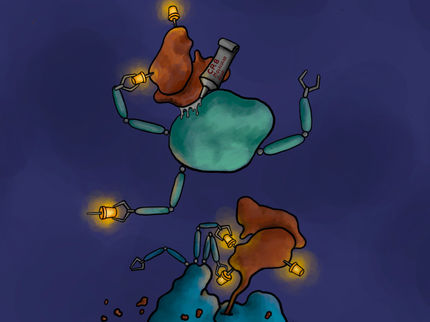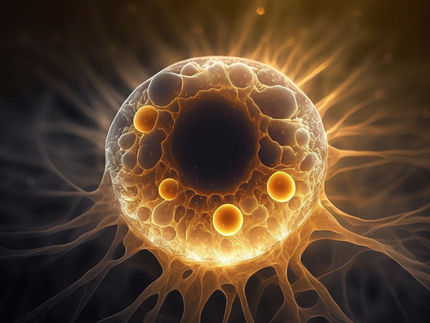Cellular protein shredders for the fight against cancer
How a cellular mechanism can be used for other purposes
Advertisement
An international team of researchers led by the Universities of Bonn and Ulm has investigated how a cell’s own "protein shredder" can be specifically programmed to fight cancer. The researchers were able to demonstrate the degradation of proteins that are overly active in breast cancer, for example.

Numerous synthesis steps have to be carried out until a PROTAC molecule is produced (in the background). Prof. Dr. Michael Gütschow (left) and Christian Steinebach (right) from the Pharmaceutical Institute at the University of Bonn discussing the data
© Barbara Frommann/Uni Bonn
Cells continuously produce proteins to be able to carry out their tasks in the body. Any protein molecules that are no longer needed are given a kind of "disposal sticker". All proteins with such a label are then crushed and recycled by a cell's own shredder, the proteasome.
For some years, researchers have been trying to harness this mechanism selectively in the fight against diseases such as cancer. After all, tumor cells also require certain proteins. If it was possible to attach a disposal label to them, they would inevitably be shredded by the proteasome, which would inhibit the growth of the cancer cell.
This approach has indeed already proven to be effective in the test tube. Here, scientists use so-called PROTACs (the abbreviation stands for "proteolysis targeting chimeras"). "However, producing these substances is very complicated," explains Prof. Dr. Michael Gütschow from the Pharmaceutical Institute of the University of Bonn. "We have investigated which strategies are promising in this respect and how particularly effective PROTACs can be customized, so to speak."
Molecular hybrids
PROTACs are molecular hybrids: They consist of both a molecular part that docks to the cancer protein, as well as a structure that can bind to the labeling enzymes. Both units are connected by a kind of arm. PROTACs thus bring the target protein and the labeling machine together, thereby ensuring that the harmful protein is given a disposal label.
"We have synthesized many molecules, among other things to find out what structure and length the arm must have in order to label the protein as effectively as possible," explains Christian Steinebach from the Pharmaceutical Institute of the University of Bonn. In addition, the researchers optimized another aspect of the PROTACs. Each cell has dozens of different labeling enzymes called ubiquitin ligases. Not all of them work equally well with every protein. "We have therefore produced and tested different PROTACs for different ligases," says Dr. Jan Krönke from Ulm University Medical Center.
The active substances developed target a protein that ensures that cancer cells can multiply better. The PROTACs now cause the cell's own shredder to destroy the protein. "In experiments with cell cultures, we were able to show that our PROTACs actually significantly reduce the cellular concentration of this protein and effectively suppress the growth of cancer cells," explains Dr. Krönke. "The substances now allow us to study proteins that are important for the tumor in more detail."
The universities of Bonn and Ulm are among the leading institutions in Germany in the young field of PROTAC research. "Our study shows prototypically which techniques can be used to produce and specifically optimize these active substances," says Gütschow. There is great interest in such strategies, since PROTACs are regarded as an important beacon of hope for the treatment of serious diseases.
Original publication
Christian Steinebach, Yuen Lam Dora Ng, Izidor Sosič, Chih-Shia Lee, Sirui Chen, Stefanie Lindner, Lan Phuong Vu, Aleša Bricelj, Reza Haschemi, Marius Monschke, Elisabeth Steinwarz, Karl G. Wagner, Gerd Bendas, Ji Luo, Michael Gütschow und Jan Krönke; "Systematic exploration of different E3 ubiquitin ligases: an approach towards potent and selective CDK6 degraders"; Chemical Science; 2020





















































